Is Dill the Same as Dill Weed? Discover the Real Difference
Cooking enthusiasts and gardening aficionados are no strangers to the tangy aroma and unique depth of flavor that Dill brings to the table. But when it comes to understanding its green companion – Dill Weed, confusion often reigns. One of the most frequently asked questions is - "Is Dill the same as Dill Weed?" While on the surface, they strikingly seem twins, with their feathery green leaves and robust aroma, a deep dive reveals similarities and differences that are worth exploring.
I’m sure many of you have wondered and even been at odds when faced with a recipe calling for fresh dill and found yourself with only a jar of dill weed. Or maybe you've grown both of these herbs in your herb garden and pondered if they are interchangeable. As a herb enthusiast myself, I’ve been down this road and hence decided to pen this post to unravel the mystery not just for myself, but for anyone else mystified by the Dill-Dill Weed conundrum.
Also Read: What is the Difference Between a Stromboli And a Calzone?
Article Includes
Is Dill the Same as Dill Weed?
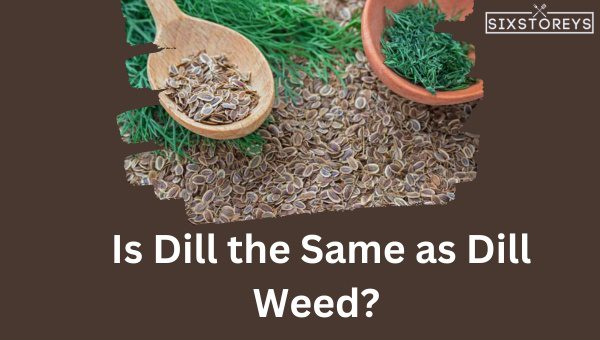
Dill and dill weed, while originating from the same plant, are distinct in terms of their physical characteristics, taste, and culinary uses.
- Physical Differences:
- Dill Seeds: When people refer to "dill" in a culinary context, they often mean the seeds of the dill plant. These seeds are small, oval, and flat with a tan or brownish color.
- Dill Weed: The term "dill weed" generally refers to the feathery, green leaves of the dill plant. These leaves are delicate, thin, and have a vibrant green color.
- Taste Variations:
- Dill Seeds: The seeds have a more robust, slightly stronger flavor. They offer a taste that lies between anise and caraway, characterized by a somewhat earthy and subtly sweet note.
- Dill Weed: The leaves, on the other hand, have a lighter, more refined flavor. They provide a fresh, slightly tangy taste that is less concentrated compared to the seeds.
- Culinary Uses:
- Dill Seeds: Due to their bold flavor, dill seeds are commonly used in recipes that can handle or require a stronger taste. They are a staple in pickling recipes and are often added to bread, providing a distinctive flavor that complements these types of dishes.
- Dill Weed: The feathery leaves are preferred for dishes that require a subtle enhancement of flavor without overpowering other ingredients. They are frequently used in salads, fish recipes, dips, and soups, adding a fresh and slightly tangy note.
- Choosing Between the Two:
- When deciding whether to use dill seeds or dill weed in a recipe, it's important to consider the flavor profile you're aiming to achieve. The choice often depends on the type of dish and the desired taste intensity.
- Summary:
- While both dill seeds and dill weed come from the same plant and share certain similarities, they each bring their own unique qualities and flavors to culinary creations. Understanding these differences is key to utilizing them effectively in various recipes.
While dill and dill weed are related, they serve different purposes in cooking, each enhancing dishes in their own unique way.
Getting to Know Dill
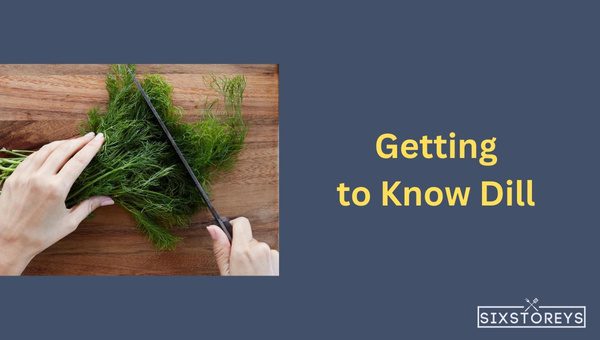
Before diving into the specifics, one needs to answer an essential question - What is Dill? Now, Dill, Anethum graveolens, is a perennial herb belonging to the celery family Apiaceae. Let's delve a little deeper.
Rich in History and Flavor
Dill has a rich history. Traces of its existence were found in the Swiss Lake dwellings dating back to the Neolithic period, about 5,000 years ago. The Greeks and Romans considered dill a sign of wealth and luck. In modern times, it's renowned worldwide for its distinctive taste and culinary versatility. Dill has a unique flavor - fresh and slightly bitter with a hint of sweet undertones. It's often described as a cross between celery and fennel, which makes it hard to replicate.
A Visual Guide to Dill
On sight, dill is a tall plant with thin, feathery green leaves. It's noteworthy that dill grows to an average height of 2-2.5 feet. While the leaves are used extensively in cooking, dill seeds are heavier and more potent, with a flavor similar to caraway.
Dill's Essential Components
The essential oil found in dill, called dillapiol, contributes significantly to its striking aroma and taste. Additionally, it is rich in vitamins A and C and contains trace amounts of various minerals.
Enter the World of Dill Weed
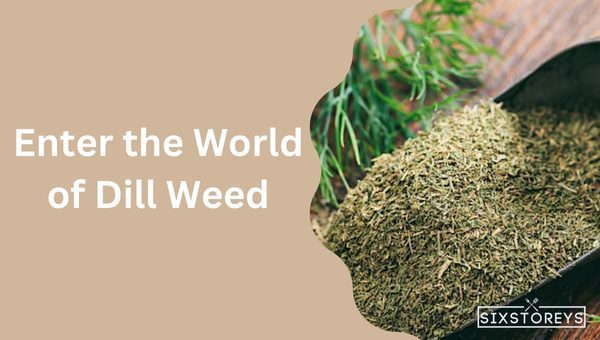
Then what about Dill Weed? Is it a different plant, or is it some form of dill in disguise? Honestly, the name can be a little confusing. Let’s clear up the confusion and take a journey into the world of dill weed.
A Misunderstood Name
Dill weed is not a separate plant. In reality, "dill weed" refers to the leafy parts of the same dill plant we discussed earlier. Hence, it's the same plant as dill, but a different element of it.
Setting Sights on Dill Weed
As we look at the dill plant, the feathery green parts we see are the dill weed. It's harvested early in the cycle before it goes into the seed mode, hence its mild and fresh flavor. The texture of dill weed is delicate, almost like that of fennel fronds.
The Flavor Factor
Dill weed has a lighter taste compared to dill seed, with a slightly grassy and sweet flavor. The herb’s signature taste comes from its oil component, limonene, which gives it a citrusy aroma. Therefore, fresh dill weed is used extensively in lighter dishes, where it adds a hint of refreshing tang.
So, both dill and dill weed come from the same plant, but they are different in appearance, taste, and certainly in their use in the kitchen. The key to using them effectively is understanding their distinct features and how they can enhance your culinary skills.
Reaping the Healthful Advantages: Dill and Dill Weed
Dill and Dill Weed are more than just flavor-enhancing herbs. In fact, they're packed with a wealth of health benefits that are sure to surprise you. Don't just relegate these herbs to a pinch in your potato salad, using them more actively in your recipes can lead to various health benefits.
Nutritional Breakdown
It might astonish you how such small leaves could hold so many vitamins and minerals. Both fresh Dill and Dill Weed are endorsed for their nutrient-rich profile. Containing Vitamins A and C, herbs like dill contribute to the overall antioxidant capacity of your diet, protecting your cells from damage by free radicals. They also both contain iron, magnesium, and calcium, contributing to healthy bones and optimal functioning of the body's processes.
Proven Health Benefits
Research has shown that the health benefits of dill and dill weed extend far beyond their nutrient content. For one, a study in the Journal of Ethnopharmacology found that dill seed extract has anti-diabetic properties, which could aid in managing type 2 diabetes. Adding to this, a review in the Journal of Herbal Medicine revealed that both herbs contain anticancer compounds known as monoterpenes, flavonoids, and phenolic acids.
Incorporating Dill and Dill Weed Into Your Diet
Bringing dill and dill weed into your daily processes is simple. They're both versatile additions to various dishes such as salads, marinades, poultry, and seafood. A simple sprinkling of chopped fresh dill or a pinch of dried dill weed before serving can add a burst of flavor and nutrients.
In the Kitchen: Versatile Uses for Dill Seed or Dill Weed
Let's kick things off by answering the question: how do you use dill seed or dill weed in your kitchen? To put it simply, both these herbs, with their licorice-like flavor, serve as a fantastic addition to a range of dishes. Their unique flavoring enhances everything from salads to soups, fish to fermentation. Now, let's break this down and look at their specific uses in culinary endeavors.
Dill Seed in the Culinary World
Dill seeds, with their somewhat sweet and slightly bitter flavor, are a common ingredient in bread, soups, pickles, and even desserts. Various cuisines, including Indian, Iranian, and European, frequently rely on dill seeds to flavor dishes.
- Pickling: Probably the most popular use of dill seeds, you'll often find them in pickling spices, adding a tangy flavor to your pickles.
- Bread Making: Dill seeds are also used for making bread, including rye bread, where the slightly tangy flavor perfectly complements the sweet taste of the bread.
- Spices and Seasonings: Ground dill seeds can serve as a seasoning or add to spice blends for a touch of warmth in the flavor.
Dill Weed becomes a Kitchen Staple
On the other hand, dill weed's delicate, feathery leaves, with a flavor hinting at anise, make it a natural choice for use in salads, soups, and sauces, and it’s quite popular with fish dishes.
- Salads: Dill weed is commonly chopped and sprinkled over a salad for a punch of flavor.
- Soups: Dill weed is often paired with lentils or added to squash and other vegetable soups for an added layer of depth in the flavor profile.
- Fish and Seafood: Many fish dishes, like gravlax and various types of seafood, are often prepared with dill weed to enhance their flavors.
Streamlining Your Cooking: Substitutes for Dill Seed and Dill Weed
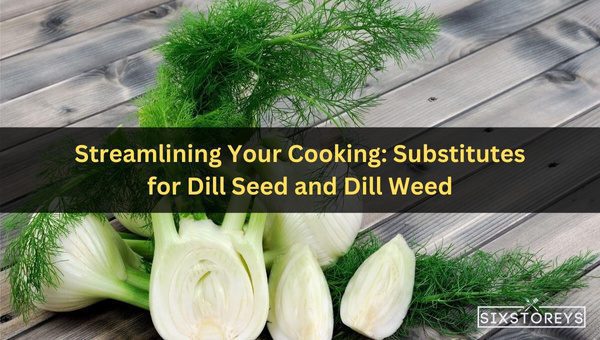
When it comes to cooking, we're often faced with the question - what if I don't have dill seed or dill weed? Well, worry no more! There are several substitutes for both these herbs that you can effortlessly incorporate into your cooking. Let's dive into this.
Potential Substitutes for Dill Seed
If you find yourself without dill seeds, there are a few viable substitutes that can save your recipe.
- Caraway Seed: Caraway seeds have a similar taste to dill seeds, making them a good option.
- Celery Seed: Although it has a more pungent and somewhat different flavor, celery seeds can serve as a substitute in bread, soups, and pickled vegetables where the taste difference won't be as noticeable.
Workaround for the Absence of Dill Weed
Finding a substitute for dill weed can be a bit trickier, mostly if your recipe heavily depends on its distinctive flavor. Here are a couple of alternatives to consider.
- Fennel Fronds: Fennel's light, feathery leaves give a similar aesthetic to your dishes, and the taste is a good stand-in for dill weed.
- Fresh Tarragon: Tarragon has a somewhat similar flavor profile and can be used in almost the same ratio as dill weed in recipes.
Just remember, while these substitutes may not give the exact flavor profile, they'll surely save your dish and lend it a delicious touch that’s worth savoring. In the world of cooking and flavor, don't be afraid to experiment and let your taste buds guide your way.
Also Read: How Long Does Tuna Salad Last In The Fridge?
Going Toe to Toe: Can I Use Dill Weed Instead Of Fresh Dill?

If you find yourself asking the question - Can I use Dill weed instead of fresh Dill? - the answer, in short, is a thumbs up. Yes, you can. However, many variables can affect this swap or substitution and shape the outcome of your dish, so let's untangle this culinary conundrum in closer detail.
Recipe Consideration
When a recipe calls for fresh dill, and you have none on hand but a jar of dill weed, fret not. The substitution ratio generally speaks of one tablespoon of fresh dill being replaced by one teaspoon of dried dill weed. Why? Simply because dried dill is more flavorful, and you'll need less of it to achieve the desired taste. However, if the recipe majorly devolves around fresh dill as a star ingredient like in tzatziki or dill cucumber salad, try to stick with fresh dill for the best outcome.
Taste and Texture
Though dill weed can replace fresh dill, keep in mind that the texture and taste will vary. Fresh dill possesses a vibrant, sweet, and slightly earthy taste that's hard to replicate. Dill weed, when dried, turns bitter with a more intense flavor. There's also a texture trade-off - fresh dill gives a nice crunch, while dried dill weed doesn't.
Cooking Time
The timing at which these are added during the cooking process is a factor too. Have a rule of thumb - add fresh herbs towards the end of cooking, while dried herbs can be added earlier. Why? Dill weed, being dry, takes time to release its flavor and aroma, but fresh dill works almost instantaneously.
The dill weed-fresh dill swap is possible, but the key lies in discerning the recipe components and adjusting accordingly to hinge on flavor payoff.
Endless Possibilities: Where to Buy and How to Store Dill and Dill Weed?
Now that we've clarified the dill weed-fresh dill swap let's venture into how and where you can source these wonders and keep them fresh.
Where to Buy Dill and Dill Weed
Thinking of adding a twist to your salad with fresh dill or contemplating a lip-numbing pickled delicacy with dill weed? Wondering where to get hold of them? Fresh dill is available in the produce section of most supermarkets, as well as farmers' markets. Dill weed, on the other hand, is commonly available in the spice aisle. Also, it's worth noting that some online marketplaces stock both fresh and dried dill. Websites like Amazon and others offer an abundant selection if local options seem lacking.
Storing Your Dill and Dill Weed
Bought a bunch of dill or a glass jar of dill weed and worried about retaining freshness? Here's how to store them.
Fresh dill should ideally be stored in the refrigerator as it wilts quickly. Wrap it loosely in a damp paper towel, place it in a plastic bag, and then in the vegetable drawer of your fridge. Fresh dill can last about a week using this method. If you wish to store fresh dill for longer, consider freezing it—Chop it finely and mix it with water or olive oil, then freeze it in an ice cube tray. Voila! Dill cubes that you can drop into your stews or fries.
Dill weed, being dried, is best stored in a dark place away from sunlight. The pantry is an ideal location. Ensure it is sealed properly to retain the flavor. Properly stored dill weed can last up to three years, but for optimal flavor, I'd recommend using it within a year.
Remember that both fresh dill and dill weed are flavor powerhouses that can elevate your culinary experience. As crucial as knowing where to buy and how to store them, is the ability to discern when to go for the fresh dill versus dill weed route in your recipe. Get this combo right, and you can conjure magical plates every time.
All About Anethum Graveolens: The Family of Dill and Dill Weed
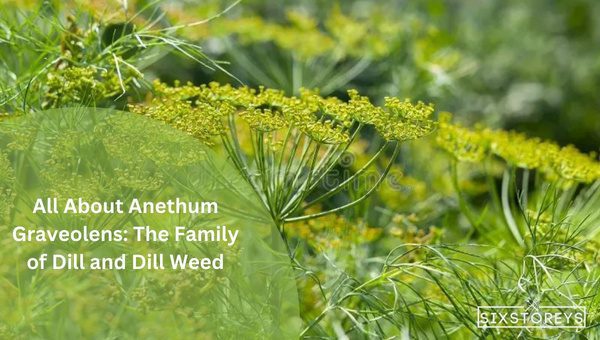
Let's embark on a journey to discover more about the family of Anethum Graveolens - the scientific name of the aromatic herb we typically refer to as Dill or Dill Weed. Coming to terms with the nomenclature puzzle is just the tip of the iceberg, as the distinct character traits of these herbaceous plants extend well beyond their names.
Scientific Classification
Dill and Dill Weed, falling under the Anethum Graveolens family, share several common traits being of the same species. They're both part of the larger umbrella of Apiaceae, or Umbelliferae, also known as the celery, carrot, or parsley family. This classification means they share genetic ties with a plethora of familiar herbs and vegetables such as fennel, coriander, cumin, caraway, celery, and even the humble carrot.
Identification Tips
Dill and Dill Weed can be surprisingly challenging to distinguish visually due to their multifaceted similarities. Both these aromatic plants exhibit delicate, feathery, and thread-like green leaves, with tiny yellow flowers eventually blooming as the plant matures. The key difference hinges on their physical structure—Dill refers to the entirety of the plant (including its stems, seeds, and leaves), while Dill Weed pertains usually to the leafy part of the plant harvested earlier before the plant flowers and produces seeds.
Dill and Dill Weed: More Than Just Flavor Enhancers
Far from being mere garnish or seasoning, Dill and Dill Weed carry a deeper significance beyond their culinary value. The admiration for these herbs intersects with culture, history, and traditional uses, making them much more than flavor enhancers.
Cultural and Historic Significance
The history of Dill and Dill Weed usage in food preparation seamlessly blends into a legacy of cultural and medicinal traditions. These herbs have been mentioned in ancient Egyptian medical texts, utilized in traditional Greek and Roman cuisine, and have found mention in biblical accounts.
Dill, derived from the Old Norse word "Dilla", implying to soothe or lull, was traditionally used for treating illnesses ranging from hiccups, stomachaches, and insomnia, to even being chewed by warriors for courage during battles.
Symbolic Uses
Religious texts, fairy tales, and folklore carry numerous mentions of Dill and Dill Weed, signifying their cultural prominence. Whether it’s being considered a lucky herb in weddings or used for protection against hexes in ancient Rome, Dill carries a symbolic charm that has endured the ages.
Dill Weed, primarily used in North American and European cuisines, has its niche carved out from older traditions and medicinal uses, now finding its place in a myriad of classic recipes ranging from pickles to soups.
The world of Dill and Dill Weed stretches beyond the confines of a kitchen spice rack – it’s a blend of science, history, and tradition with a dash of flavor and health benefits. A deeper knowledge of these versatile herbs not only elevates your kitchen endeavors but also provides a richer understanding of the cultural and historical significance these delicious herbs carry.
Busting Myths: Common Misconceptions about Dill and Dill Weed
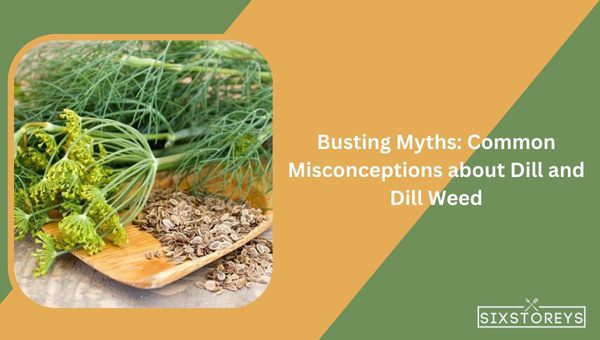
Myths have an uncanny way of creeping into every aspect of our lives, including our understanding of herbs. Dill and Dill Weed are not exempted in this. Misconceptions can often prevent us from taking full advantage of these culinary gems, so let's debunk some popular myths that surround these herbs.
Myth 1: Dill and Dill Weed are the Same
Let me start by clearing up this one. While it is true that both come from the same plant (Anethum graveolens), they are not the same thing. Dill most often refers to the seeds or the overall plant, while Dill Weed is just the feathery leaves. They both have unique flavors, with dill seeds being somewhat more pungent than dill weed leaves.
Myth 2: Dill Weed and Dill Seed are Interchangeable
While they may have intersecting uses in cooking, they are not identical substitutes. Dill Weed has a delicate flavor and is used to grace dishes like salads, roasted veggies, or soups. On the other hand, dill seeds with their bold, anise-like flavor find use in stews, pickles, and bread.
Best Practices for Growing Dill and Dill Weed
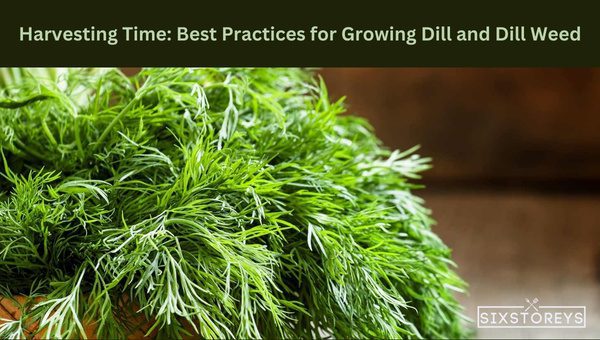
Now that you're armed with myth-busting truths about dill and dill weed, you might be inspired to grow this hearty herb yourself. Much like cleaning up misconceptions, growing dill and dill weed is rather straightforward with these best practices.
Growing Conditions for Dill
Dill appreciates a sunny location with free-draining soil. It's an annual herb, so you will need to replant it each year. Plant seeds as soon as the threat of frost has passed directly where it will grow. Dill prefers cooler temperatures and grows best in the spring and fall months.
Sowing Dill seeds
To sow your dill seeds, follow these steps:
- Prepare the planting area by removing weeds and raking the soil to a fine tilt.
- Make a trench or furrow about 1/4 inch deep and sow your seeds roughly 18 inches apart. This space will allow the plants to grow to their full potential size.
- Cover the seeds with soil and water well.
- Expect to see sprouts within 10-14 days.
Harvesting Dill and Dill Weed
Giving plenty of space between plants ensures enough area for harvesting. Dill weed can be harvested as soon as the plant has four to five leaves. When harvesting, cut from the stem's top, leaving the vertical branches, and it will continue to produce. To harvest dill seeds, let the flower heads dry on the plant, then remove them and let them dry completely in a cool, dry, and ventilated area.
Growing your own dill ensures fresh leaves and potent seeds for your recipes. By separating dill myths from facts, we learn how to take full advantage of this versatile herb, moving beyond common misconceptions into a world of flavorful culinary adventures.
Please note that this is a general guideline and growing conditions may vary depending on the specific variety of dill and the geographical location.
Dive Into the World of Preserving: Pickling with Dill and Dill Weed
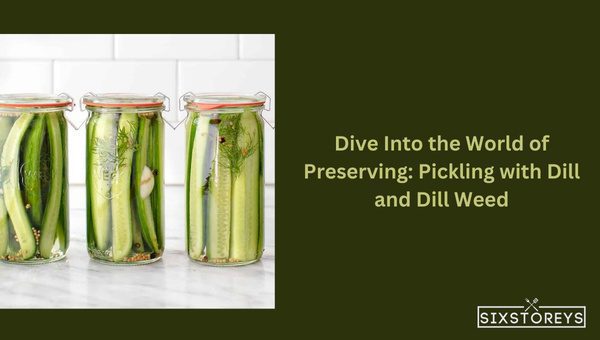
Preserving vegetables and fruits has been a time-honored tradition that spans various cultures. One particular method, pickling, has stood the test of time, not only as a preservation technique but as a way to enhance the flavor of many dishes. Dill and dill weed are quintessential ingredients in the pickling process, imparting their vibrant flavors into the mix. But how exactly do we go about using these herbs in the pickling process?
An Introduction to Pickling with Dill and Dill Weed
Pickling, in essence, is the process of preserving or extending the lifespan of food by either anaerobic fermentation in brine or immersion in vinegar. The unique sour, tangy taste of pickles is largely due to the lactic acid or acetic acid that is formed when the vegetables or fruits, like cucumbers, are soaked in these liquids.
Dill and dill weed with their distinct, aromatic, somewhat sweet flavor play a significant role in pickling. They twist the taste profile, making the pickles more than just sour. The two herbs add freshness and slight bitterness that balances the acidity of the pickles.
The Role of Dill and Dill Weed in Pickling
Dill's Contribution to the Pickling Process
Let's start with dill, also known as dill heads. This herb is particularly popular in the making of dill pickles, a variety of pickles that has a distinctive dill flavor thanks to the generous use of dill heads. Dill imparts an aromatic, slightly bitter, but fresh flavor that blends beautifully with the tang of pickles. It has an intense flavor that cuts through the sharp vinegar brine, adding depth and complexity. The dill heads, with their fronds and seeds, are generally used whole.
Dill Weed: The Unsung Hero of Pickling
On the other hand, dill weed, with its delicate, feathery leaves, brings a different note to the table. More subtle and sweeter than dill, dill weed lends a softer touch to your pickles. Its fresh grassy flavor compliments the brine nicely, resulting in a less sharp taste. Unlike dill heads, dill weed is often finely chopped before it is added to the pickling mixture.
A Simple Pickle Recipe with Dill and Dill Weed
Here is a simple recipe that you can follow to create your own pickles at home.
Ingredients:
- 4-5 medium-sized cucumbers, sliced into desired shapes
- 4 cups of water
- 2 cups of white vinegar
- 2 tablespoons of sea salt
- 2 tablespoons of sugar (optional)
- 4-5 cloves of garlic, crushed
- 2-3 sprigs of fresh dill
- 1 teaspoon of dill weed
- 1 tablespoon of pickling spice
Instructions:
- Prepare the cucumbers by washing them thoroughly and cutting them into desired shapes (spears, slices, or whole for small cucumbers). Set them aside.
- In a large saucepan, combine water, vinegar, sea salt, sugar (if using), and pickling spice. Bring the mixture to a boil and stir until the salt and sugar are completely dissolved.
- Stuff the cucumbers tightly into clean mason jars. Add crushed garlic, dill, and dill weed evenly amongst the jars.
- Pour the hot brine into the jars, ensuring that the cucumbers are completely covered.
- Let the jars cool to room temperature before sealing them. Then refrigerate them.
- Wait at least 48 hours before opening a jar to allow the flavors to fully develop. Enjoy your homemade pickles!
Diving into the world of pickling, especially with beautiful herbs like dill and dill weed, can seem a bit daunting. However, once you get the hang of it, you'll see how these herbs transform the preservation process into an art, producing the most delectable, tangy goodies for you to enjoy.
One last tip before we wrap up: To keep the flavor as fresh and lively as possible, it's best to add dill weed toward the end of the pickling process. This will ensure the sweet, grassy flavors shine through.
Pickling is a great way to get creative in the kitchen, and dill and dill weed serve as incredible allies in this flavorful adventure. So why wait? Grab those mason jars and let's get pickling!
Also Read: Acid Test: Is Mango Acidic?
Frequently Asked Questions
Is dill the same as dill weed?
No, they aren't identical. Dill generally refers to a plant's seeds and stalks, while dill weed refers to the leafy parts. However, some regions use "dill" and "dill weed" interchangeably.
Is dill weed stronger than dill?
They have distinct flavors but one isn't necessarily stronger than the other. Dill seed (dill often refers to dill seed) has a more concentrated and slightly bitter taste, while dill weed has a lighter, fresher flavor.
Can you substitute dill for dill weed in recipes?
In many recipes, they can be used interchangeably. However, keep in mind dill seed has a stronger flavor, so use less of it than you would dill weed.
Which is healthier: dill or dill weed?
Both have similar health benefits. They're rich in antioxidants and several vitamins, specifically Vitamin A and Vitamin C.
Can I use dried dill weed instead of fresh dill?
You can, but bear in mind that dried dill weed isn't as aromatic as fresh dill. Plus, the flavor might slightly change in certain recipes.
Where can I buy dill and dill weed?
Most grocery stores carry both fresh and dried versions of dill and dill weed. They're also available in health food stores and online retail sites.
How do I store dill and dill weed correctly?
Fresh dill should be wrapped in a damp paper towel and placed in a plastic bag in the refrigerator. Dill weed (dried dill) should be stored in an airtight container in a cool, dark place.
Are dill and dill weed safe to consume while pregnant?
Generally, both are safe when consumed in amounts normally found in food. However, if pregnant or breastfeeding, always consult your physician or healthcare provider before making dietary changes.
Conclusion
While the terms "dill" and "dill weed" are often used interchangeably, they do have distinctive differences. Their unique qualities in terms of aroma, taste, and health benefits make them special in their own right. Whether you're preparing a tantalizing dish or nurturing a lush herb garden, it's essential to understand these herbs' nuances. So, the next time you reach for that jar of dill weed or fresh sprigs of dill, you'll know precisely what culinary magic you're about to conjure.
Remember, when it comes to cooking - the key is in the details. Even those as subtle as the difference between dill and dill weed can elevate your cooking game to new, exciting levels. So, here's to nuanced cooking and flavorsome journeys!
